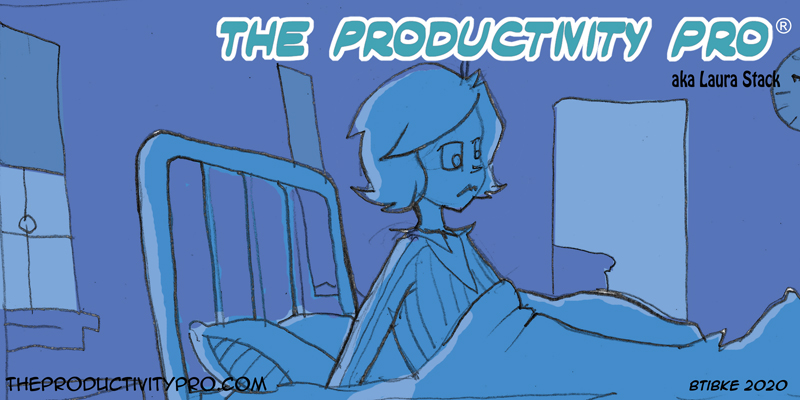“If you can’t sleep, then get up and do something instead of lying there worrying. It’s the worry that gets you, not the lack of sleep.” – Dale Carnegie, American motivational writer.
We all worry sometimes.
Most dictionaries define worry as unrelenting, repetitive, and unresolved thoughts about the same topic. But as any deep thinker knows, worrying can sometimes prove productive—especially if you come at a topic from different directions, one at a time, and can actually do something about it. The difficulty often lies in worrying constructively rather than allowing yourself to fall into a spiral of negativity.
To avoid the latter, keep two things in mind: the famous Serenity Prayer, and the difference between productive worry and its unproductive counterpart.
You may recall the Serenity Prayer, which sees use in many contexts, including motivational and productivity events. In fact, you may have heard it so often it’s become a cliché, but this makes it no less helpful if you really consider it carefully:
God, grant me the serenity to accept the things I cannot change,
The courage to change the things I can,
And the wisdom to know the difference.
Productive worry involves finding ways to change the things you can. Among other things, it is:
1. Proactive. Some might call this term another business cliché, but again, it’s a cliché because it works. If you’re worried about something you can get up and start working on, then your worry is productive. If the worrying leaves you inactive because you feel you can do nothing about whatever you’re worried about, then it’s useless. Fretting about the weather is unproductive; but if you can move forward and do something about it—say, by combatting climate change—then maybe it’s worth it. Your contribution might seem miniscule, but it is a contribution. On a more realistic scale, worrying about your next beta test may prompt you to work harder to hit your deadline, just as worrying about your health may get you to the gym.
2. Realistic. Save your worry time for things you can actually accomplish. You’re not going to find a way to erect a space elevator by next week, but you can contribute to the engineering of one that’s going up in 20 years, or to the code for the systems that will control its carriages.
3. Limited. You can’t let worry stop you dead in your tracks for very long. So if necessary, give yourself a brief time every day to worry, especially about things you can’t change. Fifteen minutes is good. You may find, however, that in time, your worry becomes productive—even for some things you thought you couldn’t change.
4. Informed. Early European settlers in the New World wasted centuries of worry on the toxicity of tomatoes, partly due to their familiarity with the “black sheep” of its extended family—deadly nightshade. Plus, they’d heard reliable reports of aristocrats dropping dead after eating tomatoes. This deprived the general populace of a wonderfully versatile crop for 200 years. But once settlers took native lore seriously and tried them, they realized tomatoes were just peachy. Recent theories about the poisonings point to pewter plates used by the aristocrats. The acids in the tomatoes apparently leached out the alloy’s lead content. (Most people didn’t take lead toxicity seriously until the 1970s.)
5. Problem-based. Anxiety doesn’t dominate productive worry; problem solving is its focus. Unproductive worry is anxiety-based.
6. Focused. Productive worry concentrates on one thing at a time. You require this for planning and preparation, or your planning will devolve into a time-wasting mess. Time management and to-do lists, therefore, are crucial for true productivity.
Walk on Faith
Productive worry is about accepting what you can’t change and moving on, while taking steps to change what you can. It guides you toward productive actions you can take to end or limit your worry. Now, you’ll always worry about some things you can’t do anything about, like family and friends. But work isn’t something to worry yourself to a frazzle over.
It takes a leap of faith to move on from worrying about what you can’t change, but even if such worry can motivate you in a negative sense, you can’t dwell on it without damaging your performance (and sanity). Instead, use productive worry to help you do what you must —prep for a beta, get training, hit a deadline, work toward promotion —while letting worry about the weekend’s weather or the state of the world float by. If you can do something to change the situation, do it. If you can’t, don’t worry about it, or at least don’t let the worry eat up your productive time.
© 2020 Laura Stack. Laura Stack, MBA, CSP, CPAE is an award-winning keynote speaker, bestselling author, and noted authority on employee and team productivity. She is the president of The Productivity Pro, Inc., a company dedicated to helping leaders increase workplace performance in high-stress environments. Stack has authored eight books, including FASTER TOGETHER: Accelerating Your Team’s Productivity (Berrett-Koehler 2018). She is a past president of the National Speakers Association, and a member of its exclusive Speaker Hall of Fame (with fewer than 175 members worldwide). Stack’s clients include Cisco Systems, Wal-Mart, and Bank of America, and she has been featured on the CBS Early Show and CNN, and in the New York Times. To have Laura Stack speak at an upcoming meeting or event, call 303-471-7401 or contact us online.



